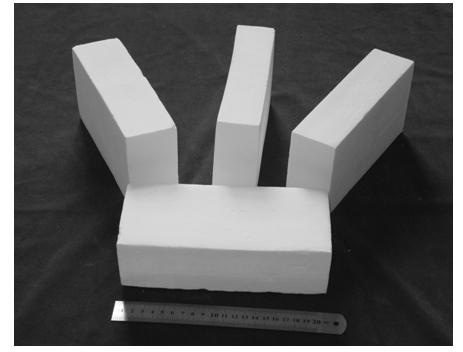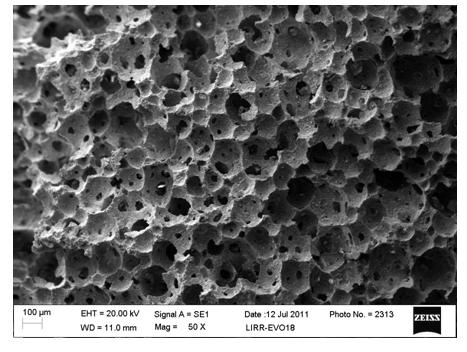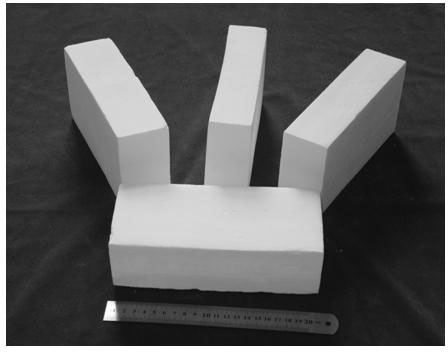Method for manufacturing light magnesia-alumina spinel insulation materials
A technology of aluminum spinel and thermal insulation material, which is applied in ceramic products, applications, household appliances, etc., to avoid sintering and cracking, use less equipment, and simplify the process.
- Summary
- Abstract
- Description
- Claims
- Application Information
AI Technical Summary
Problems solved by technology
Method used
Image
Examples
Embodiment 1
[0027] magnesite powder of 50nm, alumina powder of 100μm, water accounting for 70% of the total mass of the powder, sodium lauryl sulfate accounting for 1% of the total mass of the powder, acrylamide accounting for 20% of the total mass of the powder and N,N'-methylenebisacrylamide accounting for 5% of the mass of acrylamide was poured into the mixing drum in sequence, and stirred to obtain a foam slurry, wherein the mass ratio of magnesite powder to alumina powder was 1. Next, add ammonium persulfate accounting for 10% of the mass of acrylamide and N,N,N',N'-tetramethylethylenediamine accounting for 10% of the mass of ammonium persulfate into the foam slurry, stir well, and pour quickly To the mold, the foam slurry is solidified and formed to obtain a green body; finally, the green body is dried in an oven at 100°C, placed in a furnace, heated to 1500°C, and sintered to obtain a lightweight magnesium-aluminum spinel thermal insulation material. macro photo as figure 1 As sho...
Embodiment 2
[0031] 100 μm magnesite powder, 50nm alumina powder, water accounting for 10% of the total mass of the powder, sodium dodecylbenzenesulfonate accounting for 10% of the total mass of the powder, and formazan accounting for 1% of the total mass of the powder methacrylamide and N,N'-methylenebisacrylamide, which accounts for 20% by weight of methacrylamide, are poured into the mixing drum in turn, and stirred to obtain a foam slurry, wherein the mass ratio of magnesite powder to alumina powder is 0.6 . Add ammonium persulfate accounting for 2% of the mass of methacrylamide and N,N,N',N'-tetramethylethylenediamine accounting for 40% of the mass of ammonium persulfate into the foam slurry, stir evenly, and quickly The foam slurry is poured into a mold of a specific shape, and the foam slurry is solidified and formed to obtain a green body; the green body is dried in an oven at 100°C, placed in a furnace, and heated to 1600°C, and sintered to obtain a lightweight magnesium-aluminum ...
Embodiment 3
[0033] Mix magnesite powder of 10 μm, alumina powder of 30 μm, water accounting for 10% of the total mass of the powder, ammonium lauryl sulfate accounting for 10% of the total mass of the powder, vinylpyrrole accounting for 1% of the total mass of the powder Ketone and N,N'-methylene bisacrylamide accounting for 20% by weight of vinylpyrrole ketone were poured into the mixing drum in turn, and stirred to obtain a foam slurry, wherein the mass ratio of magnesite powder to alumina powder was 0.8. Add ammonium persulfate accounting for 2% of the mass of methacrylamide and N,N,N',N'-tetramethylethylenediamine accounting for 40% of the mass of ammonium persulfate into the foam slurry, stir evenly, and quickly The foam slurry is poured into a mold of a specific shape, and the foam slurry is solidified and formed to obtain a green body; the green body is dried in an oven at 100°C, placed in a furnace, heated to 1700°C, and sintered to obtain a lightweight magnesium-aluminum spinel th...
PUM
| Property | Measurement | Unit |
|---|---|---|
| size | aaaaa | aaaaa |
| compressive strength | aaaaa | aaaaa |
| flame retardant | aaaaa | aaaaa |
Abstract
Description
Claims
Application Information
 Login to View More
Login to View More - R&D
- Intellectual Property
- Life Sciences
- Materials
- Tech Scout
- Unparalleled Data Quality
- Higher Quality Content
- 60% Fewer Hallucinations
Browse by: Latest US Patents, China's latest patents, Technical Efficacy Thesaurus, Application Domain, Technology Topic, Popular Technical Reports.
© 2025 PatSnap. All rights reserved.Legal|Privacy policy|Modern Slavery Act Transparency Statement|Sitemap|About US| Contact US: help@patsnap.com



